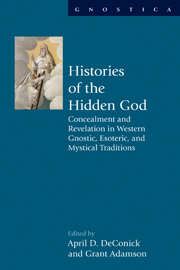 Histories of the Hidden God
Histories of the Hidden God Book contents
- Frontmatter
- Contents
- Acknowledgments
- Contributors
- Introduction: In search of the hidden God
- Part I Concealment of the Hidden God
- Part II The Human Quest for the Hidden God
- Part III Revelations of the Hidden God
- Afterword: Mysticism, Gnosticism, and esotericism as entangled discourses
- Bibliography
- Index
Introduction: In search of the hidden God
- Frontmatter
- Contents
- Acknowledgments
- Contributors
- Introduction: In search of the hidden God
- Part I Concealment of the Hidden God
- Part II The Human Quest for the Hidden God
- Part III Revelations of the Hidden God
- Afterword: Mysticism, Gnosticism, and esotericism as entangled discourses
- Bibliography
- Index
Summary
A GOD AT ONCE KNOWN AND UNKNOWN
In Western religious traditions, God is conventionally conceived to be a humanlike creator, lawgiver, and king. In the Hebrew bible, he is not pictured as an incorporeal deity. Rather he has a form – a tselem and a demut – that is humanlike. He possesses body parts: a face, hands, ears, mouth, fingers and feet. He is enthroned in the highest heaven and rules the universe from his celestial temple. So in the scriptures he is lauded as the God of the Heavens. He is the astral Lord, known as the god whose throne is heaven and whose footstool is the earth. He talks to the Israelites out of the heavens and his luminous embodied image, the kavod, can be seen in heaven by visionaries like Ezekiel.
His heavenly presence, however, is not the whole story. This is a god who also was believed to have a physical presence in the sky and on earth. He is the god who manifests himself in the cosmos, riding on the clouds, whose appearances or theophanies are accompanied by thunder, lightning, rain, and earthquake. In the biblical literature, the temple – the replica of his heavenly station – was believed to house God's presence in Jerusalem, although its limited size was such that it could barely contain the fringes of his mantle.
- Type
- Chapter
- Information
- Histories of the Hidden GodConcealment and Revelation in Western Gnostic, Esoteric, and Mystical Traditions, pp. 1 - 12Publisher: Acumen PublishingPrint publication year: 2013


